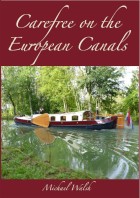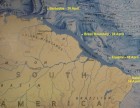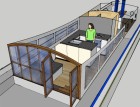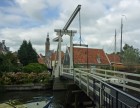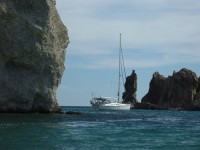Sequitur
Michael & Edi have headed out on a slow, thorough exploration of the globe.
| Vessel Name: | Sequitur and Zonder Zorg |
| Vessel Make/Model: | 2007 Hunter 49 and 1908 Wildschut Skûtsje |
| Hailing Port: | Vancouver, Canada |
| Crew: | Michael Walsh & Edi Gelin |
| About: | For our current location click, on Map & Tracking, then on the Google Earth logo. |
| Extra: | Follow us on Twitter: Follow @YachtSequitur |
| Social: |
13 January 2014
Another New Book Released
I am delighted to announce that my new book: Carefree on the European Canals is now in print and is available on Amazon.com, Amazon.ca [...]
26 April 2013
New Book Released
The proof copy of my new book arrived by courier today. I have approved it and it is now listed on Amazon for pre-order, with a publication date of 30 April. It is a rather large book at 680 pages in an 8.5 by 11 inch format with 315,000 words illustrated by over 2400 colour photos, charts and maps. [...]
24 April 2013
One Year Out of Brazil
One year ago today we sailed Sequitur out of Brazil after enduring more than six weeks in the least-friendly country that we had experienced during our three-year voyage. In the early evening of 24 April 2012 we crossed the line on the chart dividing Brazil from French Guyana and breathed a huge sigh [...]
27 October 2012 | Harlingen, Friesland
Planing a Metamorphosis
We have added a new post to the Zonder Zorg blog at: Planing a Metamorphosis.
29 September 2012 | Sneek, Netherlands
Onward to Friesland
We have arrived in Friesland and have added a new post to the skûtsje's blog at: Onward to Friesland
19 September 2012 | Hoorn, Netherlands
North From Aalsmeer
We have moved northward from Aalsmeer and I have added two new posts: Heading North From Aalsmeer and North From Amsterdam
13 September 2012 | Aalsmeer, Netherlands
Taking Possession
We are back in the Netherlands, and I have added some new posts to the ZonderZorg blog at: Taking Possession and Settling-In and Making Plans
20 August 2012 | Sequitur: St Augustine, USA - Michael & Edi: Vancouver, Canada - Nieuwe Zorg: Aalsmeer, Netherlands
Added a New Website
We have added a new website: Skûtsje ZonderZorg. Zonder zorg in Dutch means without worry. Our intention with the site is to provide a place to share some of the history, geography and culture of the skûtsje as we discover it. We will also use this place to document [...]
11 August 2012 | Sequitur: St Augustine, USA - Michael & Edi: Vancouver, Canada - Nieuwe Zorg: Aalsmeer, Netherlands
Still More Skûtsje History
We continued to attempt to track-down Douwe Albert Visser, who was the owner of Nieuwe Zorg in 1941 when she was re-registered. One of the problems we repeatedly encountered in our online searches was the effect of currently having Albert Visser and two Douwe Vissers as very competitive skûtsje racers, [...]
10 August 2012 | Sequitur: St Augustine, USA - Michael & Edi: Vancouver, Canada - Nieuwe Zorg: Aalsmeer, Netherlands
Some More Skûtsje History
While I was researching the history of Nieuwe Zorg, I finally found her first registration details obscured by an apparent typographical error in a transcribed online spreadsheet. She was listed as having been built in 1901 instead of 1908. I emailed the webmaster of the [...]
Ashore in Guaymas


In response to our question on Thursday afternoon, Omar had told us that there were seafood stalls along the street past the end of the malecon, but that it was a very long walk. When we told him we had walked over to the Soriana and back the other day, he changed his mind, and said the fish stalls were quite close. We found them after a very pleasant walk of just short of two kilometres that took us past the end of the formal waterfront and into a less tamed setting.

There were three stalls, one beside a fish processing plant on the water, and two across the road beneath a line of low bluffs. We crossed the road and compared the wares in the cases of the two stalls, and settled on the nearer stall. Not only was there a better selection, but there was a line-up of customers, one of whom had parked her Mercedes in front; the other stall had no customers. Over the years, I have had good results using the if-it-is-full-of-locals method as an indication of quality.
We saw what looked like jumbo scallops, but oblong rather than round, about five by seven centimetres in size and three centimetres thick. Through our non-Spanish and the non-English of the two staff, we asked what they were, and were told scallops. Although the shape and the surrounding white cowl told us they were different to our accustomed scallops, we bought a kilogram for 250 pesos.

On our way out to the fish stalls we had watched a pelican trying to swallow a fish, which was quite apparently too large for its gullet. On our way back to Sequitur, the pelican was still trying to down the fish, so we stopped again to watch. We were not the only audience; there were determined gulls and other pelicans waiting for a chance at the catch. We pondered the bird's plight and were thankful that humans have found a more sedate and enjoyable way to eat.
We headed in through some of the business streets on our way back, stopping to look at the produce selection in one small supermarket, and quickly striking it off our list. Kitty corner from it was Especias Naturales de Mexico, a bulk foods store. We found slivered almonds, and I weighed-out a half kilo of them so I will no longer have to hand sliver or julienne whole almonds for my almandines. Edi found a bin of sliced dried ginger, so we will now have that special tang back in our wok. Down the street we found a liquor store with a good selection of wine, and picked a couple of inexpensive bottles to see if their contents warrant adding more to Sequitur's cellar.

For Friday evening's dinner, I experimented with the 'scallops'. They were very dense, almost the texture of abalone, but not the shape. I seared them in a dry, very hot pan, then added a bit of butter and julienned garlic and sauteed them for a while longer. This was served with basmati rice and steamed broccoli with a garnish of sliced tomato and tomatillo. With dinner we drank Chambrule Brut, a classic method bubbly from Baja, whose major positive characteristic turned out to be its low price. The 'scallops' had the delicacy and flavour of scallops, but their texture was a bit tougher and stringier.
I spent considerable time on Saturday morning Googling around on the net, trying without success to find out what our 'scallops' were, and how to best cook them. I finally concluded, that whatever there are, I would prepare the next batch as if they were abalone; sliced, pounded, panko coated and very quickly sauteed in butter.

As we were busily lazing around on the Internet, we heard the first emergency vehicle sirens we've heard during our two-and-a-half months in Mexico. Half an hour later we heard more; this time I popped my head up into the cockpit to see what was going on. The Guaymas Bomberos were slowly driving by on the malecon just off Sequitur's quarter. The very modern pump truck had its sirens wailing, horns honking, lights flashing and was loaded to capacity with delighted children. Every half hour for the next several hours, they repeated the treat with more excited children.
Mid afternoon we finally got serious about tracking down the source of a tiny seep of fresh water into the compartment beneath the pantry sole. I had long suspected that it had something to do with the washer/dryer installed in a cupboard there, but had not as yet found the water's source. To eliminate other possibilities, we dug out the contents of the starboard aft compartment, beneath what used to be the queen-sized bed platform. There is no liner, just the inside of the hull, and it was totally dry, with no evidence of there ever having been moisture there.
The washer/dryer occupies a cupboard in the bulkhead between the pantry and the sea cabin, with the user access through cabinet doors on the pantry side and access to the back-end stuff behind panels in the cabinet in the sea cabin. I removed the panel and found all hose connections tight, with no evidence of any previous leaks. What I saw next really surprised me; there was a dryer vent duct leading out of the back of the machine. This was supposed to be a ventless dryer, so why the vent ducting? It led aft, into the compartment beneath the bed platform, but where did it go from there?
Next we lifted the queen-sized mattress and the starboard forward access cover to the compartment beneath the bed platform. The duct led into the compartment and terminated in an empty lint trap box, which simply lay on the bottom of the compartment. Surrounding it, and on every surface in the compartment was lint, and in the lower front end of the compartment there was a wet pad of lint. Stains on the compartment bottom spoke of there having been at times puddles of various sizes. The hot, moist exhaust from the dryer had no place to go but to condense and run forward, down the slope of the hull and accumulate in a growing pad of lint.

I removed the ducting and cleaned the lint from the compartment, then I set-up a temporary vent out through the small Bomar portlight into the cockpit, and Edi started a load of laundry to try-out the machine. With the vent now led outside, the pantry and sea cabin no longer got humid during the dry cycle. I dug-out the user's manuals that had come with the machine to find we had one of each; one for the ventless model, and one for the vented.
It appears that the wrong model was ordered, or had been received by the factory, and whoever installed it was not supervised, and simply left the vent flopping in a blind space, and forgot about it, or otherwise didn't report it. The space spans the width of the boat, and its after portion accommodates the main diesel tank. The port side forward houses the isolation transformers for the 120v and the 240v shore power connections. The last time I looked in there, we hadn't yet run the washer/dryer, and there would have been no telltale lint, and I would probably have glanced past the metal vent duct, dismissing it as being part of the diesel furnace ducting.
I then read through the manual for the Splendide 2000S vented model and searched online for its installation sheet to give me some ideas on designing a proper vent for Sequitur's laundry. One of the problems, of course, is the watertight integrity of the boat, and a prudent mariner should always think carefully before cutting any hole through the hull, particularly an 11cm diameter hole. Sequitur's two aft cabins already sport five 13cm by 30cm holes through the hull, which are sealed by opening Bomar portlights. Two of these lead into the cockpit, directly above the washer/dryer.
There is a clearance of 13cm above the washer/dryer, so it makes sense to us to run a new piece of ducting across its top to the pantry side of the bulkhead and let it out through a new 11cm hole at the top of the after face of the cabinetry. From a fitting there, a flexible piece of ducting can hang down and be clipped out of the way in the corner when not in use. On its end would be a flange, which is sized to fit into the opened portlight, and to be secured in place with the existing dogs. On laundry days, when we wish to use the dryer, we can open the portlight, unclip the vent duct, introduce it to the opening and dog it in place.
With the prospect of such a huge project, we decided to start resting-up, and we spent the evening relaxing and browsing the Internet, interrupted only by a delicious dinner of garlic butter sauteed basa fillets. In celebration of Saturday night, there was loud music blasting from various venues ashore, according to Edi, but one of the few benefits of being nearly deaf is that I heard very little but the thump, thump, thump of the base notes.

